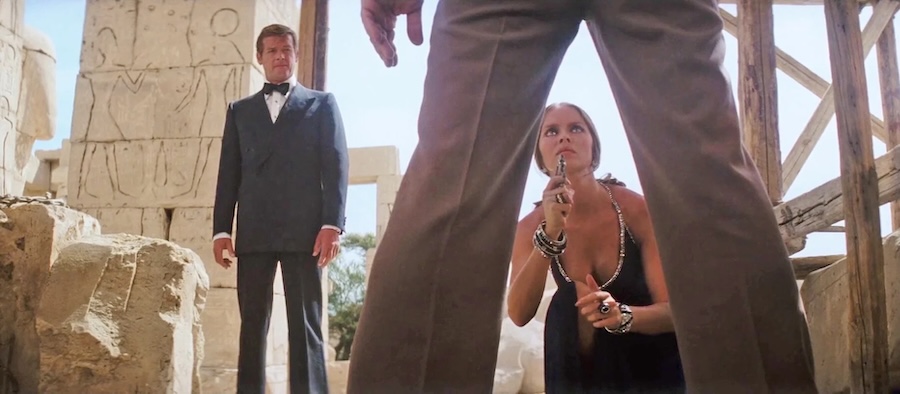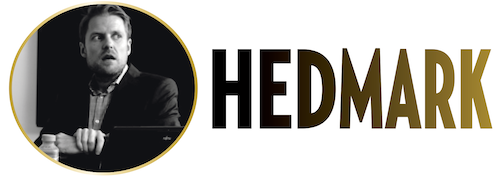
IT’S THE BIGGEST. IT’S THE BEST. IT’S BOND. AND B-E-Y-O-N-D!

There are many reasons why this tenth chapter is my favorite of the James Bond movies, along with Goldfinger (1964). One of them could be that Roger Moore was the first actor I ever saw play Bond (I’m too young to have experienced Sean Connery at the height of his career), and this is easily his best effort. The Spy Who Loved Me was so good that the writers of the next film in the series seemed to simply give up and decide to just remake this one. Moonraker was amusing, but this is the original.
Crowd-pleaser of an opening
James Bond is ordered to “pull out” of his current mission. As he’s bedding a woman in a ski cottage, he literally pulls out, puts his skis on and is immediately followed by several agents. After killing one of them, he goes off the edge of a cliff and the music stops – until the silence is interrupted by the classic Bond theme as 007’s parachute (modeled after the Union Jack) opens. What a great crowd-pleaser of an opening and it is followed by the title sequence, featuring some unforgettable music. The song is “Nobody Does It Better”, superbly performed by Carly Simon; this salute to 007 was nominated for an Oscar.
When the story begins in earnest, Bond learns that a British nuclear submarine has disappeared and he’s sent to Cairo to gather intelligence. So is his Soviet equivalent, Anya Amasova (Barbara Bach); her country has also mysteriously lost a submarine. While in Egypt, both of them encounter a dangerous hit man called Jaws (Richard Kiel), a giant of a man with steel teeth, and they also obtain a precious microfilm. Anya double-crosses Bond, but their superiors force them to cooperate.
The microfilm leads them to Carl Stromberg (Curd Jürgens), a peculiar industrialist who is fascinated with everything oceanic. It turns out that Jaws works for Stromberg and that the billionaire is planning to destroy the world and start a new civilization at the bottom of the ocean.
Grand, exciting and exceptionally entertaining
There were those who found this film starting the trend of turning Bond flicks into family-oriented adventure movies with oversized budgets and too much silliness. I can sympathize, but this is nevertheless a grand, exciting and exceptionally entertaining film where Moore, after two test runs, is truly comfortable as James Bond. He’s funny, charming and deadly, capable of creating a character that fits him better than Sean Connery. Jürgens, a German character actor, is perfect as the insane Stromberg, and Kiel is as much a classic Bond villain as Oddjob in Goldfinger – almost impossible to defeat, until Bond understands his critical weakness. Bach is one of the best Bond girls, primarily because she’s an unusually resourceful character, a woman who can take out Bond if that’s what’s required of her.
The action sequences are great fun, including the Egyptian adventure, and the car chase that ends with the Lotus driving into the sea and turning into a submarine.
The Spy Who Loved Me stands for what was good about the Roger Moore era.
Some people will always regard this chapter as the beginning of the end. Actually, The Spy Who Loved Me stands for what was good about the Roger Moore era.
The Spy Who Loved Me 1977-U.K.-U.S. 125 min. Color. Widescreen. Directed by Lewis Gilbert. Screenplay: Christopher Wood, Richard Maibaum. Music: Marvin Hamlisch. Song: ”Nobody Does It Better” (performed by Carly Simon). Cast: Roger Moore (James Bond), Barbara Bach (Anya Amasova), Curd Jürgens (Carl Stromberg), Richard Kiel (Jaws), Caroline Munro, Bernard Lee, Desmond Llewellyn, Lois Maxwell.
Trivia: The writers were given permission to use Ian Fleming’s title for the novel but not the actual novel, because Fleming was unhappy with it. Robert Brown appears as an admiral; he would later play M in four Bond films. Catherine Deneuve and Marthe Keller were considered for the female lead. Followed by Moonraker (1979).
Quote: “When one is in Egypt, one should delve deeply into its treasures.” (Moore visiting a harem)
Last word: “I was presented with a script when I got to London (from France) but had no idea that – apparently – so many writers had contributed to what I was given. I would have been terrified had I known. […] The script had Jaws and the sub-guzzler and, I seem to recall, we are talking twenty-five years ago, plus – Norwegian fjords and a bunch of young revolutionaries. I remember thinking that it was very distant from the Bonds that I had enjoyed and recommending back to basics. Nearly everything in the movie was written by me, but in the course of many conferences with Lewis, Cubby and Michael Wilson – who was also a Bond debutante at that time. I enjoyed writing the novelizations and went to great pains to reread Fleming. It was a real challenge to integrate the extra-ordinary world of film Bond into the more prosaic, real life settings of the novels.” (Wood, Shatterhand007)
